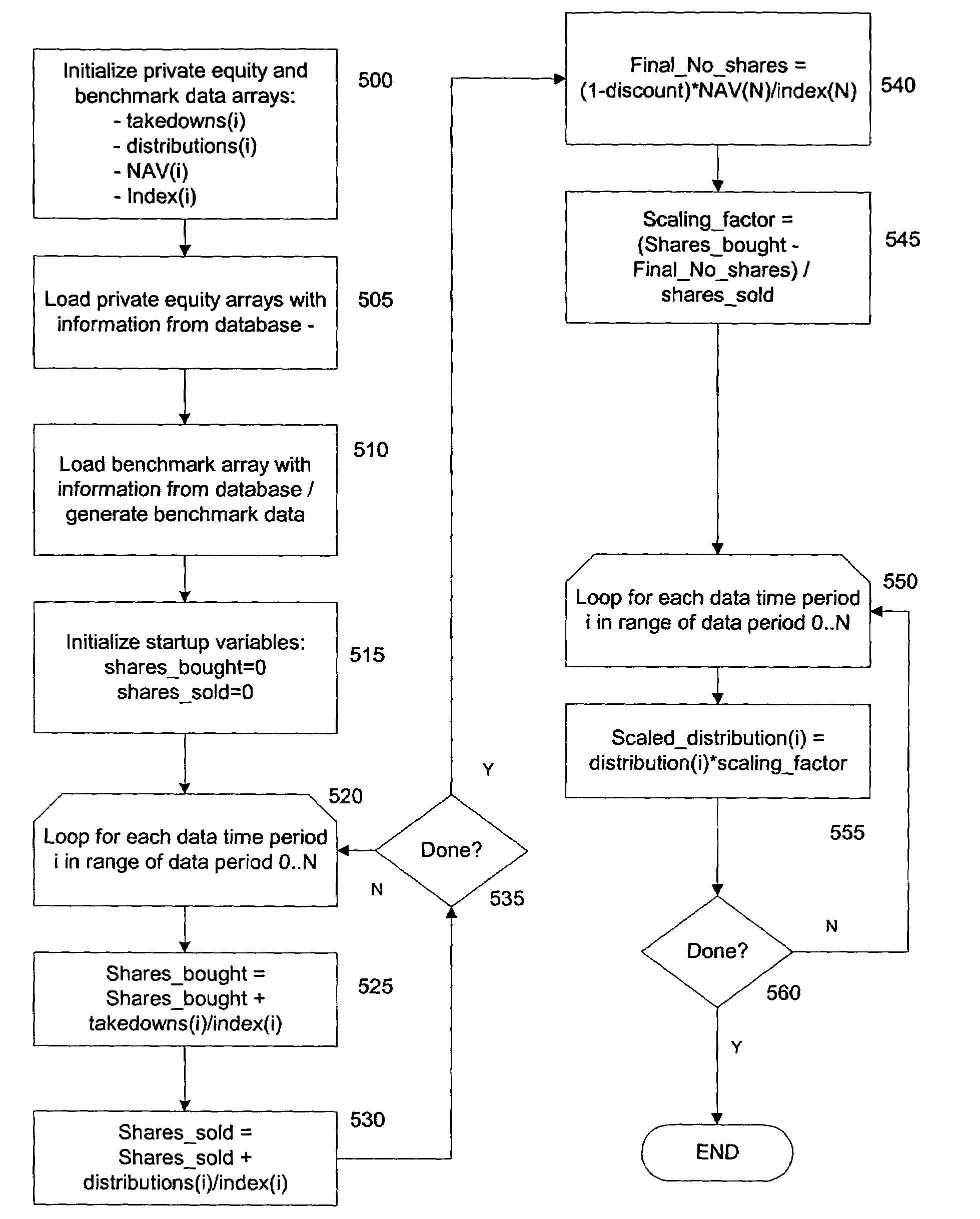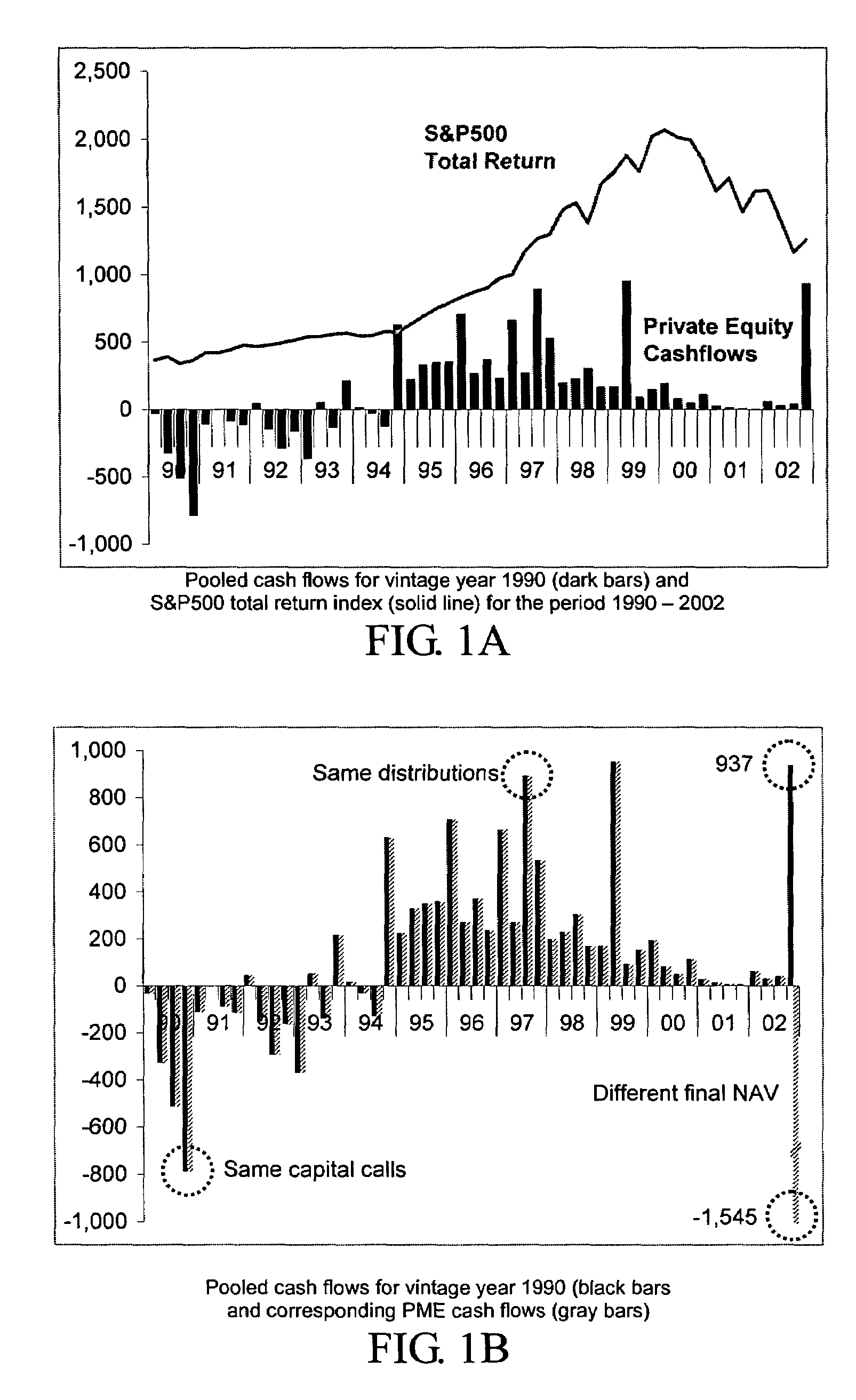Method and system for modeling and benchmarking private equity and applications of same
a technology of private equity and benchmarking, applied in the field of portfolio analysis, can solve the problems of not being able to directly compare the performance, the twr not yielding useful results for situations, and the difficulty of direct comparison between a private equity and other types of asset classes, and achieve the effect of accurate simulation of the behavior
- Summary
- Abstract
- Description
- Claims
- Application Information
AI Technical Summary
Benefits of technology
Problems solved by technology
Method used
Image
Examples
example 1
Evaluation of a Private Equity Performance Relative to a Benchmark
[0094]The cash flow for a private equity asset can be used to determine a scaling factor that can be used to compare performance of the asset with that of a benchmark. The cash flow can be from a single private equity asset or for multiple assets as appropriate, such as the cash flow for the entire asset class of a particular vintage year. For example, the cash flows from Jan. 1, 1990 to Dec. 31, 1999 can be applied to a benchmark fund valued on the S&P 500 Total Returns index. A scaling factor is selected so that the ending values of the private equity investment and the S&P500 total returns benchmark fund are the same. The magnitude of the scaling indicates how well the private equity asset performed relative to a fully diversified portfolio of public securities as represented by the S&P500.
[0095]With reference to FIG. 11A, there is shown a simplified set of index data and a corresponding set of private equity cash ...
example 2
Performance Comparison of Multiple Private Equities
[0098]The evaluation of a single private equity (or aggregate of private equities), as discussed above, can be performed separately for different private equities relative to the same index. The scaling factors determined for each private equity set can then be compared to each other. The difference between the scaling factors provides an indication of how well each of the equities performed relative to the pubic index and thereby how well they performed relative to each other. Advantageously, this allows the relative performance of the different private equities to be compared even if the timing of the cash flow events are different. This technique provides an alternative for the conventional technique of directly comparing IRRs of the private equities.
example 3
Generation of Scaled Private Equity Data for Use, e.g., During Analysis Under Market Conditions for which Private Equity Performance Data is not Available
[0099]Private equity performance data representing individual or pooled cash flows can be scaled to allow mapping of the data to a stream of public equity performance data, as represented by an index, for which actual private equity performance data is not available. The known private equity cash flow is applied to the public equity performance data and the cash flow scaled so that the performance or other attribute of the private equity has the desired relationship to the benchmark. The relationship can be predefined, such as where private equity performance is assumed to equal public market performance, or the relationship can be determined by initial analysis, such as by performing a benchmark comparison of the performance of private equity relative to a benchmark for a period where data for both private equity cash flow and the...
PUM
 Login to View More
Login to View More Abstract
Description
Claims
Application Information
 Login to View More
Login to View More - R&D
- Intellectual Property
- Life Sciences
- Materials
- Tech Scout
- Unparalleled Data Quality
- Higher Quality Content
- 60% Fewer Hallucinations
Browse by: Latest US Patents, China's latest patents, Technical Efficacy Thesaurus, Application Domain, Technology Topic, Popular Technical Reports.
© 2025 PatSnap. All rights reserved.Legal|Privacy policy|Modern Slavery Act Transparency Statement|Sitemap|About US| Contact US: help@patsnap.com



